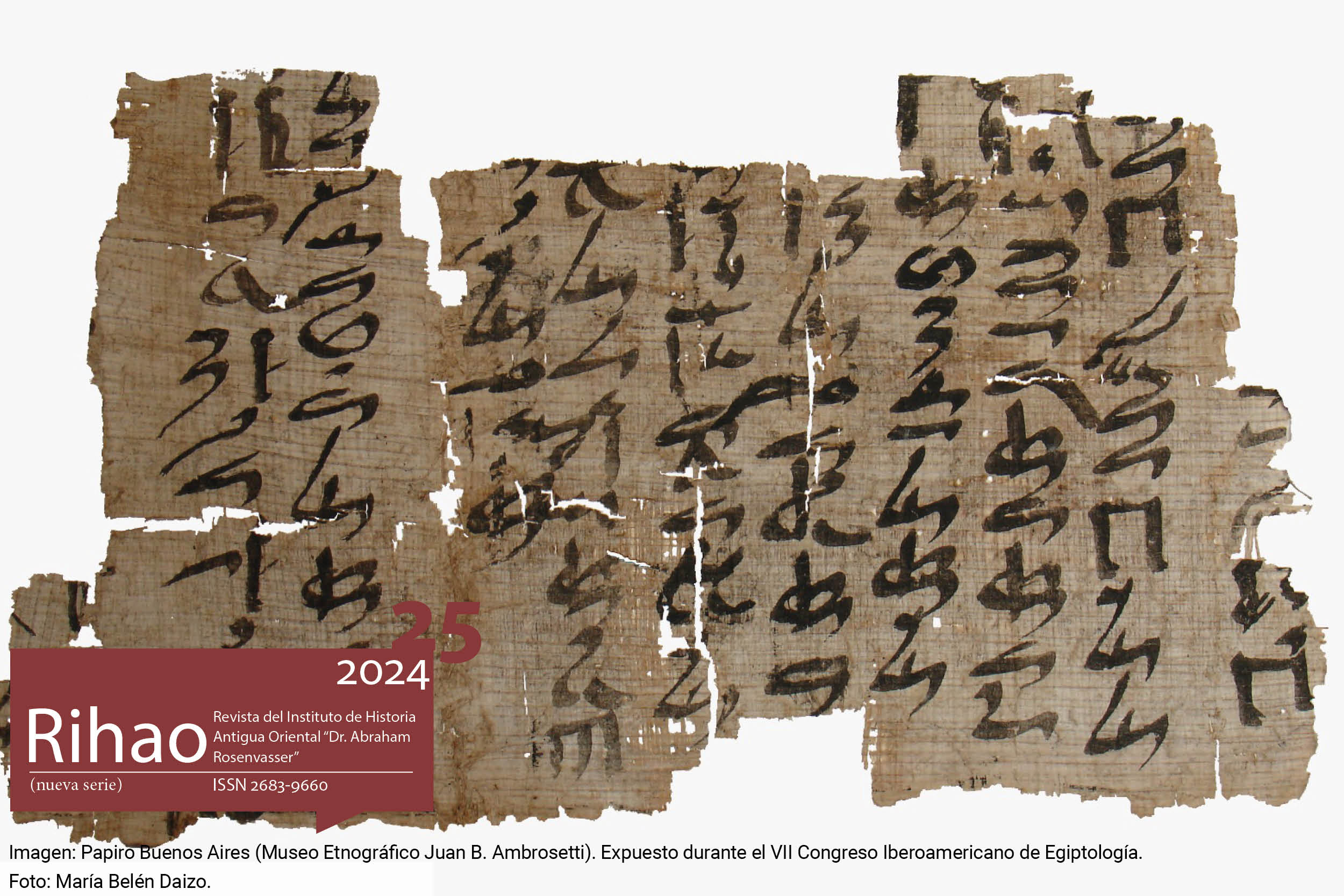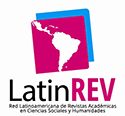Hacia una teoría del arte egipcio pre-canónico
Resumen
Los dos desarrollos más importantes de las últimas décadas en el campo del arte egipcio fueron la idea de canon (desarrollada por Whitney Davis) y la de decorum (término de John Baines). Tanto Baines como Davis insisten en que el estilo de figuración tan particular de los egipcios obedece a elecciones conscientes de artistas dentro de un marco cultural específico. Como parte de mi propuesta señalo que el arte del período Predinástico (ca. 3900-3200 a.C.) no cuenta con un canon, pero sí con un decoro que es propio del período, es decir, pre-canónico. Debido a la especificidad del arte del Predinástico, cuando no había en Egipto escritura, un canon estético definido ni una unidad política territorial, es necesario desarrollar una teoría del arte egipcio pre-canónico que permita abordarlo en sí mismo y no en función de los desarrollos posteriores. Esto es, no como su “fase formativa” sino como una forma particular del mismo. Propongo aquí desarrollar un herramental teórico y metodológico que nos permita ubicar las figuraciones del período Predinástico dentro de la historia del período. Me interesa llegar a construir una teoría del arte egipcio pre-canónico que sirva de plataforma a ulteriores estudios, propios y de otros investigadores del área.Descargas
Citas
Aldred, C. (1952). The Development of Ancient Egyptian Art. From 3200 to 1315 B.C. Londres: Alec Tiranti.
Ataç, M.-A. (2015). Egyptian Connections with the Larger World: Ancient Near East, en: Hartwig, M. K. (2015), A Companion to Egyptian Art (Blackwell Companions to the Ancient World). West Sussex: Wiley, 423-446.
Baines, J. (1994). On the Status and Purposes of Ancient Egyptian Art, en: Cambridge Archaeological Journal 4 (1): 67-94.
Baines, J. (2007). Visual and Written Culture in Ancient Egypt. Oxford: Oxford University Press.
Bárta, M. (2014). Prehistoric Mind in Context: An Essay on Possible Roots of ancient Egyptian Civilisation, en: Kristiansen, K., Smejda, L. y Turek, J. (eds.), Paradigm Found: Archaeological Theory - Present, Past and Future. Essays in Honour of Evzen Neustupny. Oxford: Oxbow, 188-204.
Brémont, A. (2018). Into the Wild? Rethinking the Dynastic Conception of the Desert beyond Nature and Culture, en: Journal of Ancient Egyptian Interconnections 17: 1-17.
Brémont, A. (2021). L’envers du décor. Perspectives archéologiques et anthropologiques sur l’iconographie animale nagadienne (ca. 3800-3100 av. J.-C.): production, consommation, représentations. Tesis de doctorado. París: Sorbonne Université.
Brown, M. W. (2015). ‘Keeping Enemies Closer’: Ascribed Material Agency in Ancient Egyptian Rock Inscriptions and the Projection of Presence and Power in Liminal Regions. Tesis de doctorado. New Haven: Yale University.
Budka, J. (2020). Zum Nachleben Winckelmanns in der ägyptologischen Kunstgeschichte in Deutschland, en: Aegyptiaca. Journal of the History of Reception of Ancient Egypt 5: 32-65.
Bussmann, R. (2014). Egyptian Archaeology and Social Anthropology, en: The Oxford Handbook of Topics in Archaeology. En línea: https://academic.oup.com/edited-volume/43506/chapter/364130910. [Consultado: 20-6-2023].
Campagno, M. (2002). De los jefes-parientes a los reyes-dioses. Surgimiento y consolidación del Estado en el antiguo Egipto (Aula Ægyptiaca-Studia 3). Barcelona: Aula Ægyptiaca.
Campagno, M. (2006). Prólogo, en: Campagno, M. (ed.), Estudios sobre parentesco y Estado en el antiguo Egipto. Buenos Aires: Del Signo, 9-13.
Capart, J. (1904). Les débuts de l’art en Égypte. Bruselas: Vromant & Co.
Cervelló Autuori, J. (2011). Narmer-Menes: discontinuidad histórica y refundación mítica, en: Belmonte, J. A. y Oliva, J. (coords.), Esta Toledo, aquella Babilonia. Convivencia e interacción en las sociedades del Oriente y del Mediterráneo antiguos. Cuenca: Ediciones de la Universidad de Castilla-La Mancha, 479-518.
Červíček, P. (1986). Rock Pictures of Upper Egypt and Nubia. Nápoles: Istituto Universitario Orientale.
Davis, W. (1976). The Origins of Register Composition in Predynastic Egyptian Art, en: Journal of the American Oriental Society 96 (3): 404-418.
Davis, W. (1985). The Canonical Tradition in Ancient Egyptian Art. Tesis de doctorado. Cambridge: Harvard University.
Davis, W. (1992). Masking the Blow. The Scene of Representation in Late Prehistoric Egyptian Art. Berkeley: University of California Press.
Davis, W. (2007). Abducting the Agency of Art, en: Osborne, R. y Tanner, J. (eds.), Art’s Agency and Art History. Oxford: Blackwell, 199-219.
Descola, P. (2005). Par-delà nature et culture. París: Gallimard.
Dreyer, G. (1992). The Royal Tombs of Abydos, en: Kernerr, S. (ed.), The Near East in Antiquity, vol. 3. Amán: Al Kutba, Publishers / German Protestant Institute for Archaeology, 55-67.
Evans, L. (2010). Animal Behaviour in Egyptian Art. Representations of the Natural World in Memphite Tomb Scenes. Oxford: Aris & Phillips.
Gell, A. (1998). Art and Agency: An Anthropological Theory. Oxford: ClarendonPress.
Hendrickx, S. (2011a). Iconography of the Predynastic and Early Dynastic Periods, en: Teeter, E. (ed.), Before the Pyramids. The Origins of Egyptian Civilization (Oriental Institute Museum Publications 33). Chicago: The Oriental Institute of the University of Chicago, 75-81.
Hendrickx, S. (2011b). Composite animal palette, en: Teeter, E. (ed.), Before the Pyramids. The Origins of Egyptian Civilization (Oriental Institute Museum Publications 33). Chicago: The Oriental Institute of the University of Chicago, 200-201.
Hendrickx, S. (2014). The Emergence of the Egyptian State, en: Bahn, P. y Renfrew, C. (eds.), The Cambridge World Prehistory. Cambridge: Cambridge University Press, 259-278.
Hsu, S.-W. (2011). The ‘Griffin’ as a Visual and Written Image for the King, en: Göttinger Miszellen 231: 45-56.
Kubler, G. (1962). The Shape of Time. Remarks on the History of Things. New Haven / Londres: Yale University Press.
Laboury, D. (2017). Tradition and Creativity. Toward a Study of Intericonicity in Ancient Egyptian Art, en: Gillen, T. (ed.), (Re)Productive Traditions in Ancient Egypt. Lieja: Presses Universitaires de Liège, 229-258.
Lucarelli, R. (2023). “When Everything Is Human, the Human Is an Entirely Different Thing...” Animal Powers in the Ancient Egyptian Demonic Imagery and Beyond, en: Journal of Ancient Near Eastern Religions 23: 56-68.
Lustig, J. (1997). Anthropology and Egyptology. A Developing Dialogue (Monographs in Mediterranean Archaeology 8). Sheffield: Sheffield Academic Press.
Malek. J. (1999). Egyptian Art. Londres: Phaidon.
Maydana, S. F. (2020). Hippopotamus Hunting in Predynastic Egypt: Reassessing Archaeozoological Evidence, en: Archaeofauna 29: 137-150.
Maydana, S. F. (2021). Bringing the Desert to the Nile: Some Thoughts on a Predynastic Terracotta Model, en: Archéo-Nil 31: 61-82.
Maydana, S. F. (2022). ¿Arte? egipcio: una introducción, en: Revista del Instituto de Historia Antigua Oriental “Dr. Abraham Rosenvasser” 23: 137-156.
Morenz, L. D. (2014). Anfänge der ägyptischen Kunst: Eine problemgeschichtliche Einführung in ägyptologische Bild-Anthropologie. Friburgo / Gotinga: Academic Press.
Moxey, K. (2008). Visual Studies and the Iconic Turn, en: Journal of Visual Culture 7 (2): 131-146.
Nyord, R. (2013). Vision and conceptualization in ancient Egyptian art, en: Caballero, R. y Díaz Vera, J. E. (eds.), Sensuous Cognition. Explorations into Human Sentience: Imagination, (E)motion and Perception. Berlín: De Gruyter, 135-168.
Nyord, R. (2020). Seeing Perfection. Ancient Egyptian Images Beyond Representation. Cambridge: Cambridge University Press.
Patch, D. C. (2011). Dawn of Egyptian Art. Nueva York: Metropolitan Museum of Art.
Pizzato, G. (2019). The Fantastic Creatures in Predynastic Egypt: An Essay about Near-Eastern Influences, en: Journal of Intercultural and Interdisciplinary Archaeology 3: 29-38.
Polkowski, P. (2020). World of Images or Imaginary World? Rock Art, Landscape, and Agency in the Western Desert of Egypt, en: Sonderschriften des Deutschen Archäologischen Instituts, Abteilung Kairo 43: 255-283.
Quibell, J. E. (1898). Slate Palette from Hierakonpolis, en: Zeitschrift für Ägyptische Sprache und Altertumskunde 36: 81-84.
Robins, G. (1997). The Art of Ancient Egypt. Cambridge: Harvard University Press.
Rogner, F. (2020). Prestige durch Bilder. Variationen und Entwicklungen des Motivs der Wüstenjagd in thebanischen Grabkapellen der 18. Dynastie, en: Serova, D., Backes, B., Götz, M. W. y Verbovsek, A. (eds.), (Un)Sterblichkeit: Schrift - Körper - Kult. Beiträge des neunten Berliner Arbeitskreises Junge Aegyptologie (BAJA 9) (Göttinger Orientforschungen IV 67). Wiesbaden: Harrassowitz, 157-174.
Schäfer, H. (1974 [1919]). Principles of Egyptian Art. Traducción de John Baines. Oxford: Clarendon Press.
van Walsem, R. (2005). Iconography of Old Kingdom Elite Tombs. Analysis & Interpretation, Theoretical and Methodological Aspects. Leiden / Lovaina: Peeters.
Verderame, L. (2013). Osservazioni a margine dei concetti di ‘ibrido’ e ‘mostro’ in Mesopotamia, en: Baglioni, I. (ed.), Monstra. Construzione e Percezione delle Entità Ibride e Mostruose nel Mediterraneo Antico. Primo Volume (Egitto, Vicino Oriente Antico, Area Storico-Comparativa). Roma: Edizione Quasar, 160-174.
Vivas Sainz, I. (2016). The Artist in his Context: New Tendencies on the Research of Ancient Egyptian Art, en: Trabajos de Egiptología 7: 203-220.
Vivas Sainz, I. (2023). An Unusual Graffito in the Cachette Wadi. Hunting in the Desert Boundary? Meaning, Function and Authorship, en: el-Aguizy, O. y Kasparian, B. (eds.), ICE XII. Proceedings of the Twelfth International Congress of Egyptologists, 3rd-8th November 2019 (Bibliothèque générale 71). El Cairo: Institut français d’archéologie orientale Publications, 527-534.
Wengrow, D. (2001). The Evolution of Simplicity: Aesthetic Labour and Social Change in the Neolithic Near East, en: World Archaeology 33 (2): 168-188.
Wengrow, D. (2006). The Archaeology of Early Egypt: Social Transformations in North-East Africa, c.10,000 to 2,650 BC (Cambridge World Archaeology). Cambridge: Cambridge University Press.
Wengrow, D. (2007). Enchantment and Sacrifice in Early Egypt, en: Osborne, R. (ed.), Art’s Agency and Art History. Oxford: Blackwell, 28-41.
Winckelmann, J. J. (1873 [1764]). The History of Ancient Art. Traducido del alemán por G. Henry Lodge. Boston: James R. Osgood and Company.
Yoffee, N. (2001). The Evolution of Simplicity (Scott’s Seeing like a State), en: Current Anthropology 42 (5): 767-769.
Derechos de autor 2024 Sebastián F. Maydana

Esta obra está bajo licencia internacional Creative Commons Reconocimiento-NoComercial 4.0.





.jpg)







